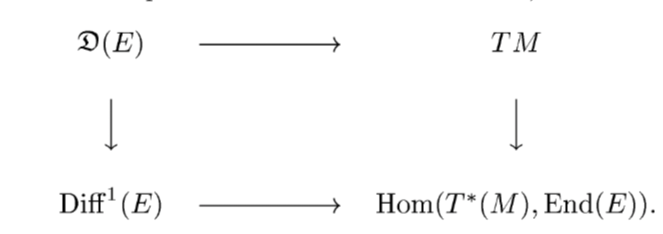I am trying to write my understanding of "Lie algebroid of derivations $\mathcal{D}(E)\rightarrow M$ associated to a vector bundle $E\rightarrow M$".
Given a vector bundle $E\rightarrow M$, we want to associate a Lie algebroid over $M$. The first thing that comes to mind about Lie algebroid (even before a smooth map to $M$) is that there is a Lie algebra.
Given a vector bundle $E\rightarrow M$, we have a collection of vector spaces $\{E_m\}_{m\in M}$ indexed by elements of $M$. Every vector space gives a Lie algebra $\rm{End}(V)$. This collection of vector spaces $\{E_m\}_{m\in M}$ would also give a collection of Lie algebras $\{\rm{End}(E_m)\}_{m\in }$ indexed by elements of $M$. Even though fibers of vector bundles are vector spaces, it is usually not the case that the fiber of Lie algebroid is a Lie algebra. So, it is unlikely that this collection $\{\rm{End}(E_m)\}_{m\in M}$ of Lie algebras indexed over elements of $M$ would give an(y) interesting Lie algebroid over $M$. I would like to know if this is of any interest, any comments are welcome.
Given a vector bundle $E\rightarrow M$, there is another vector space associated to it, namely, the global sections $\Gamma(M,E)$. This would also give a Lie algebra $\rm{End}(\Gamma(M,E))$. But, there are two issues here:
- Is there a vector bundle $P\rightarrow M$ for which $\Gamma(M,P)=\rm{End}(\Gamma(M,E))$.
- Is there any nice vector bundle map $P\rightarrow TM$ that fits in the definition of Lie algebroid?
If we focus on subsets of ${\rm End}(\Gamma(M,E))$ that are $C^\infty(M)$-linear then there is the endomorphism bundle. Otherwise, it is not clear what could be a choice. Note that we should also be able to assign a map from that subspace of sections to the sections of the tangent bundle. It is not clear how do you assign a vector field on $M$ for a $C^\infty(M)$-linear map of sections.
The terms "vector field on $M$" and "linear maps $\Gamma(M,E)\rightarrow \Gamma(M,E)$ (satisfying some conditions)" together should remind the notion of connection on the vector bundle $E\rightarrow M$. Given a connection $\nabla:\Gamma(M,TM)\times \Gamma(M,E)\rightarrow \Gamma(M,E)$, for each vector field $X\in \Gamma(M,TM)$ we have the associated linear map $\nabla(X,-):\Gamma(M,E)\rightarrow \Gamma(M,E)$. (Un)forturnately, given a connection, the maps $\nabla(X,-)$ are not $C^\infty(M)$-linear. In fact, we have the property $$\nabla(X,-) (f\alpha)=f\nabla(X,-)(s)+X(f)s.$$
One can extract this property and look at maps $\Gamma(M,E)\rightarrow \Gamma(M,E)$ satisfying the property mentioned above. To be more precise, we are looking at maps $D:\Gamma(M,E)\rightarrow \Gamma(M,E)$ for which there exists a vector field $D_X\in \Gamma(M,TM)$ satisfying the condition $$D(f\alpha)=fD(\alpha)+D_X(f)\alpha.$$ These maps are called as derivative endomorphism in Mackenzie's General theory of Lie groupoids and Lie algebroids
If we denote this subset of derivative endomorphisms by $S$, we have a map $S\rightarrow \Gamma(M,TM)$, sending $D$ to $D_X$ (at this point, I do not know if for a given $D$, there can be more than one vector fields $D_X$ associated to $D$). Now, we need to know if this $S$ is the space of sections of some vector bundle.
This construction of vector bundles is done in two steps. Firstly, we look at a more general notion of first order differential operators (see regarding first order differential operator and derivative endomorphism). It is "understood" that, this first order differential operators are sections of vector bundle ${\rm Diff}^1(E)\rightarrow M$ (if you know any place that gives some details about this bundle, please leave references in comments).
This set of derivative endomorphisms is a subset of first order differential operators that has something to do with vector fields, as in the following diagram,

To "construct" the vector bundle associated to the vector space on the top left corner, an obvious first step to do is to take "pullback" with appropriate maps from ${\rm Diff}^1(E)$ and $TM$ to an appropriate manifold (that is also a vector bundle over $M$).
Whenever we want something common between two properties, we take "intersection". An appropriate notion of "intersection" is the pullback. The question is pullback with respect to which manifolds and which maps. The candidate for that is ${\rm{Hom}}(T^*M, {\rm End}(E))$. They define some bundle morphisms
${\rm Diff}^1(E)\rightarrow {\rm{Hom}}(T^*M, {\rm End}(E))$ and $TM\rightarrow {\rm{Hom}}(T^*M, {\rm End}(E))$ and declare the pullback to be the Lie algebroid of derivations $\mathcal{D}(E)\rightarrow M$ as in the following diagram,

This is the construction of Lie algebroid of derivations for a vector bundle $E\rightarrow M$.


